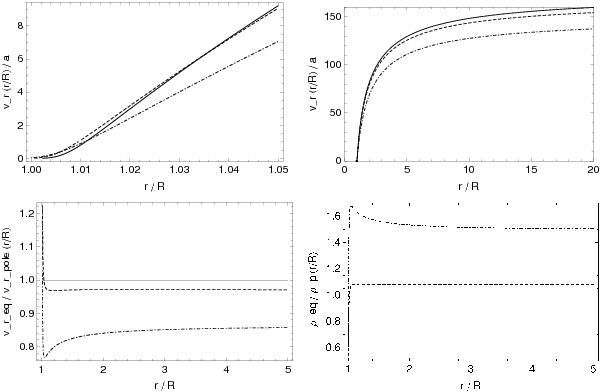Fig. 3

Model results for the wind from a differentially rotating O5–V main-sequence star without distortion with an equatorial rotation speed of Vrot = 300 km s-1 (see dashed curves) and 500 km s-1 (see dotted-dashed curves) at the equator (for θ = π/2), compared to the spherical wind from a corresponding non-rotating star (Vrot = 0) which is identical to the wind from the rotating star at the pole for θ = 0 (see solid curves or solid horizontal lines, respectively); as for the stellar and wind parameters see Table 1 in Sect. 4. All diagrams are plotted vs. radial distance  in units of the stellar core radius R = 11.757 R⊙. Upper panel: the amount of the radial wind velocity component
in units of the stellar core radius R = 11.757 R⊙. Upper panel: the amount of the radial wind velocity component  (in units of sound speed a) in the subsonic and lower supersonic wind regime (see left diagram), and in the supersonic region up to stellar distances of
(in units of sound speed a) in the subsonic and lower supersonic wind regime (see left diagram), and in the supersonic region up to stellar distances of  (see right diagram). Lower panel: the left diagram displays the curves of the ratio
(see right diagram). Lower panel: the left diagram displays the curves of the ratio  of the equatorial radial wind velocity compared to the polar wind velocity and the right diagram shows the ratio
of the equatorial radial wind velocity compared to the polar wind velocity and the right diagram shows the ratio  of the equatorial wind density in terms of the density at the pole. For the pole, these ratios are simply represented by the (solid) constant lines at 1.0; at the equator the density ratios approach (for large stellar distances
of the equatorial wind density in terms of the density at the pole. For the pole, these ratios are simply represented by the (solid) constant lines at 1.0; at the equator the density ratios approach (for large stellar distances  ) the terminal values represented by the thin horizontal dashed or dotted-dashed line, respectively, in the right diagram.
) the terminal values represented by the thin horizontal dashed or dotted-dashed line, respectively, in the right diagram.
Current usage metrics show cumulative count of Article Views (full-text article views including HTML views, PDF and ePub downloads, according to the available data) and Abstracts Views on Vision4Press platform.
Data correspond to usage on the plateform after 2015. The current usage metrics is available 48-96 hours after online publication and is updated daily on week days.
Initial download of the metrics may take a while.




